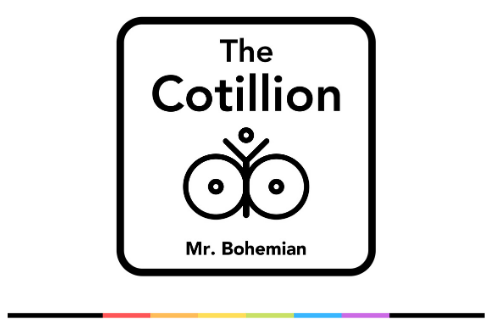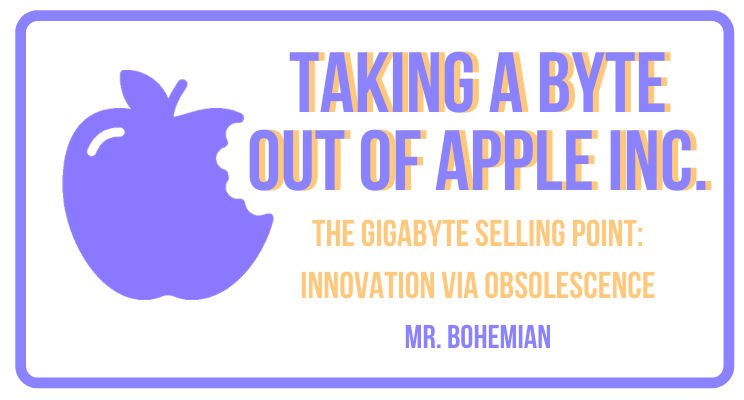Taking a Byte Out of Apple Inc: Innovation via Obsolescence
Photo by Federica Galli on Unsplash
Many consumers know, with mixed fanfare, that purchasing an elite Apple product can come at an elite price. Many willfully pick up the "Apple Tax" simply because they adore Apple's forward facing designs in their homes. Others understand it comes with advanced features, such as an ergonomically swift interface, for example, swooping around in Mission Control.
Whatever one's wallet has to say about Apple, all consumers get equally queasy in the Apple section when they start to see the "Apple Tax" rise exponentially... by the gigabyte.
Has the trillion dollar Apple always been stingy and underwhelming with features? Wasn't their shining e-Jerusalem founded on the "alternative" and "deluxe" (and no Windows)? So claimed their epic, 1984 Super Bowl commercial to deny Big Brother's conformity.
The inverse, relative to their traditional inversion from the norm, is what they've slowly begun indoctrinating their consumer base with, against the holy tradition of the Patriarchs. The Scripture of Apple's Exile from their identity is recorded in the gigabyte: the vessel of their Coding's patrimony.
Memory's Memory 💾
Computer memory is a historical checkpoint of technological competence. Byte hardware has optimized significantly since Apple's first, 1976 wooden computer, the Apple I, which hosted a humble 4 kilobyte memory. Stand back, because it was upgradable to 8kB!
Hit ⏭ into the next millennium; the first iPod from 2001 hosted 5–10 GB of storage in the palm of one's hand. Steve Jobs was soon to invent that phrase with his first iPhone in 2007. In only six years past the iPod's so-so debut, the much-awaited iPod "Classic" model was released with a massive storage tank of 80–160GB. It was the only bone big enough to throw to the song-hungry masses who, simultaneously, couldn't get enough of Apple's chic'n awesome design and easy interface.
Double for Nothing 🎲
The unique look n' feel features of Apple tech alone, however, do not leave one literally paying double. During the time Jobs released the aesthetically beloved iPhone 4 in 2010, memory was silently and veritably becoming a forceful customer selling point. While the pioneering iPhone teetered along on a minimum of 4–8 GB, the first iPad confirmed Apple's intentionality to hold their concessions via a dip in feature quality, rather than gift the world with Silicon Valley sophistication. Despite handheld storage reaching an economical zenith with the iPod Classic, the 2010 first gen iPad started its history with a miserable 16GB.
Compared to the Patriarch of the iPod 1 at 5-10 GB, at least the iPad is a good internet-looker-thing, eh? Buy now. Cheap. Amazon.com
Selfish? Hardly. Common and deluxe consumers pay the "Apple Tax" to receive deluxe products. They don't want to be a part of toyish business model for sophisticated gimmicks.
Popularity was rising; the need to entice demand was lowering. At this point, Apple was making its for-profit compromises, rather than completely melting the generous ethics of putting the world in one's iHand.
Gigabytes, meanwhile, started routing the timeline of Atlantis's sinking.
The Soldiers of Soldering 🧵
“Soldering," within the subject of technology, is the event of a manufacturer or handler using a soldering iron to mini-weld two parts together to form a secure, permanent bond.
Soldering, in the Past, is typically meant to be undone via the process of desoldering. This was done to replace or salvage parts. In secular times, Apple has perversely "soldered" negative connotations to the denotation of "solder" with the greedy business practice of an irreversible stitch to their mainstay manufacturing.
This is done to various, once replaceable parts on their computer's motherboard, from the RAM to the hard disk storage. Not just for proprietary domination, but this is ultimately done to push the principal product at the onset of an inevitable, minor malfunction. In essence, the consumer can't replace a Soldered part when it fries. Thus, the three thousand dollar Device is as strong as the weakest part.
Bring it to the Genius; then, he'll merely do the hokey-pokey with your laptop in the backroom while dialing your proprietary insurance company, Insurance, or Care.
The reasons from technology companies are typically a red herring appeal to the flux capacitor: Back to the Future's science fictitious device for time travel in DeLoreans. The appeal to the flux capacitor is a personally coined fallacy for a business using bogus pretenses with the facade of technological specialization. The common user will be stupefied by the Silicon Valley™ reasoning, but not the intermediates and above with a specialized common sense:
“We solder the hard drive to the mommy-board to better facilitate the Mac OS Hotdog internet waves being injected into the mommy-board’s flux capacitor via the World Wide Web”
Everyone: Ooooh.
*Inserts crinkled dollar bills into CD drive.*
My Laptop RAM Away. 💻⚡️
In mid 2019, my own MacBook Pro 2017 was working fine on low-processing duty. All of a sudden—evil blackness out of nowhere......
Evil.
What happened? After a boot up, the internal diagnosis showed a malfunction with the RAM. Okay. The RAM sticks are typically replaceable... "in older models."
What was the betrayed Laity to do? In an upside-down church, where obsolescence is innovation, my counter-flip was to downgrade to upgrade.
I purchased Apple's MacBook Pro Mid 2012: It was the last laptop that was given papal permission by Apple to reconcile venial and mortal sins via a replaceable hard drive, RAM, keyboard, screen, and more.
Photo by Mr. Bohemian
It's a wonder why secular Apple allows this residual pop-up against their current campaign to teach consumers that RAM isn't replaceable without enough flux capacitor juice. Hard soldering is the permanent fix for Silicon Valley's™ unethical future.
If an Acolyte tells you that RAM must be hard soldered for a pretense of user benefit, merely remind them that the Apple I's memory could be upgraded from 4kB to 8.
The Dongle Jungle 🙊
Photo by Mr. Bohemian
The "dongle" is a connection device, typically an adaptor. A notorious example is the schlong that hung from the iPhone 7 that debuted without a headphone jack in 2016. Particularly with the advent of CEO Tim Cook, Apple has had an increase in dongle-jungle fever. Like soldering's previously innocent usage, unnecessary dongle pushing has been exaggerated as a business ploy by Apple:
Apple HQ circa 2015
Tim Cook: We need more dongles.
Everyone: y.
Tim Cook: Dongle dongle dongle.
Everyone: "Dongle dongle dongle."
My new laptop's name is Sam SE. My old hardware was named Sam, but I kept her soul and my documents in the Mac Time Machine, the data backup software. After a dongle-syringe of flux capacitor juice into the Time Machine, I booted Sam up into her "Special Edition," 2012 hardware.
She's pretty sweet. She's got all of the following ports and more:
MagSafe power port (hnnng)
gigabit Ethernet port
FireWire 800 port (up to 800 Mbps)
two USB 3 ports (up to 5 Gbps)
thunderbolt port (up to 10 Gbps)
headphone port
SDXC card slot
Kensington lock slot
8x SuperDrive
Sam's old, 2017 hardware had the following:
a USB-C slot
a USB-C slot
an empty bag of Cheetos
a headphone jack, because of the iPhone 7's backlash.
Apple has consistently appealed to the flux capacitor to justify the need for the dongle, but can they actually use it to justify why there's only two? While Apple may be poisoning their products with obsolescence, the future customer may have enough memory of Apple's power play to take their business elsewhere.
“Pecked to Death by Ducks” Apple Macintosh advertisement against Windows.
What has Apple done to their faithful gigabyte thus far since their Patriarchs?
gigabyte greed
gigabyte soldering
dongle dongle gigabyte
For the Apostles, Saints, Celebrants, and Laity, the whole commerciality was merely half of the issue of Apple's degenerating identity. For the true faithful of the Church, it's barely small talk. The Spirit has been soldered to its cross. It yearns for the homeland: installation into Scripture 2.0 with ironic involution—but in vain.
There's not enough gigabytes for Mac OS Prophecy.
Mr. Jobs did not invent the computer. Mr. Jobs did not invent the music player. Mr. Jobs did not invent the touch screen or smartphone. How did his make it to 1 T.?
His pre-assembled computer and its keyboard was the first, “personal” computer.
His music player was as styled and human oriented as the music it contained.
His iPhone was an Blessing to mankind: “to put the world in one’s iHand.”
“Taking a Byte Out of Apple Inc: Innovation via Obsolescence”
By Mr. Bohemian






